Christo and Jeanne-Claude
| Christo and Jeanne-Claude | |
|---|---|
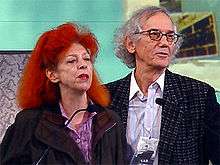 Jeanne-Claude and Christo in April 2005 | |
| Born |
June 13, 1935 (both) (age 83) (Christo) Gabrovo, Bulgaria (Christo) Casablanca, Morocco (Jeanne-Claude) |
| Died |
November 18, 2009 (aged 74) (Jeanne-Claude) Manhattan, New York, United States |
| Education |
Christo: National Academy of Arts Vienna Academy of Fine Arts Jeanne-Claude: Self–taught |
| Known for | Environmental art |
| Notable work |
Running Fence The Gates The Floating Piers |
| Movement |
Nouveau réalisme Environmental art |
| Awards | Praemium Imperiale |
| Website |
christojeanneclaude |
Christo Vladimirov Javacheff and Jeanne-Claude are a married couple who created environmental works of art. Christo and Jeanne-Claude were born on the same day, June 13, 1935; Christo in Gabrovo, Bulgaria, and Jeanne-Claude in Morocco. They first met in Paris in October 1958 when Christo painted a portrait of Jeanne-Claude's mother. They then fell in love through creating art work together.
Their works include the wrapping of the Reichstag in Berlin and the Pont-Neuf bridge in Paris, the 24-mile (39 km)-long artwork called Running Fence in Sonoma and Marin counties in California, and The Gates in New York City's Central Park.
Credit was given to "Christo" only, until 1994, when the outdoor works and large indoor installations were retroactively credited to "Christo and Jeanne-Claude."[1] They flew in separate planes: in case one crashed, the other could continue their work.[2]
Jeanne-Claude died, aged 74, on November 18, 2009, from complications of a brain aneurysm.[1]
Although their work is visually impressive and often controversial as a result of its scale, the artists have repeatedly denied that their projects contain any deeper meaning than their immediate aesthetic impact. The purpose of their art, they contend, is simply to create works of art for joy and beauty and to create new ways of seeing familiar landscapes. Art critic David Bourdon has described Christo's wrappings as a "revelation through concealment."[3] To his critics Christo replies, "I am an artist, and I have to have courage ... Do you know that I don't have any artworks that exist? They all go away when they're finished. Only the preparatory drawings, and collages are left, giving my works an almost legendary character. I think it takes much greater courage to create things to be gone than to create things that will remain."[4]
Personal life
Christo
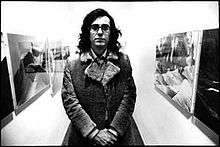
Christo (Bulgarian: Христо Владимиров Явашев) was born in Gabrovo, Bulgaria. His father, Vladimir Javacheff, was a businessman and ran a fabric factory, and his mother, Tsveta Dimitrova, was the secretary at the Academy of Fine Arts in Sofia. Professors from the Academy who visited his family observed Christo's artistic talent while he was still very young.
Christo studied art at the Sofia Academy from 1953 to 1956 and went to Prague, Czechoslovakia (now Czech Republic), until 1957, when he left for the West by bribing a railway official and stowing away with several others on board a train transporting medicine and medical supplies to Austria.
Christo quickly settled in Vienna and enrolled at the Vienna Academy of Fine Arts. After only one semester there, he traveled to Geneva and moved to Paris in 1958. His life in Paris was characterized by financial hardship and social isolation, which was worsened by his difficulty learning French language. He earned money by painting portraits, which he likened to prostitution and signed with his family name "Javachef" while his early works were signed "Christo." In 1973, after 17 stateless years, Christo became a United States citizen.[5]
Jeanne-Claude
Jeanne-Claude Denat de Guillebon came from an old French family. She was born in Casablanca, Morocco, where her father, an army officer, was stationed. Her mother, Précilda, was 17 when she married Jeanne-Claude's father, Major Léon Denat. Précilda and Léon Denat divorced shortly after Jeanne-Claude was born, and Précilda remarried three times. Jeanne-Claude earned a baccalauréat in Latin and philosophy in 1952 from the University of Tunis.[1]
During World War II, Jeanne-Claude lived with her father's family while her mother fought in the French Resistance. In 1946, Précilda married the influential General Jacques de Guillebon. The family lived in Berne from 1948 to 1951, then in Tunisia from 1952 to 1957, when they returned to Paris.
She was described as "extroverted" and with natural organizational abilities. Her hair was dyed red, a color she claimed was selected by her husband[6] and she smoked cigarettes, and tried to quit many times until her weight would balloon. She did not enjoy cooking.[7] She took responsibility for overseeing work crews and for raising funds.[2] She said she became an artist out of love for Christo (if he'd been a dentist, she said she'd have become a dentist).[8]
Jeanne-Claude died in New York City on November 18, 2009, from complications due to a brain aneurysm. Her body was to be donated to science, one of her wishes.[9]
Former Mayor of New York City Michael Bloomberg described The Gates as “one of the most exciting public art projects ever put on anywhere in the world—and it would never have happened without Jeanne-Claude.”[1] Jeanne-Claude said, "Our art has absolutely no purpose, except to be a work of art. We do not give messages."[10] She also said, "Artists don't retire. They die. That's all. When they stop being able to create art, they die."[11]
When she died, she and Christo were at work on Over the River, a set of fabric panels over the Arkansas River in Colorado (begun in 1992)[7] and The Mastaba, a stack of 410,000 oil barrels configured as a mastaba, a trapezoidal prism, in the United Arab Emirates.[1][12]
Marriage
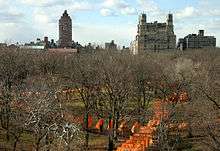
Christo and Jeanne-Claude met in October 1958, when he was commissioned to paint a portrait of her mother, Précilda de Guillebon. Initially, Christo was attracted to Jeanne-Claude's half-sister, Joyce. Jeanne-Claude was engaged to Philippe Planchon. Shortly before her wedding, Jeanne-Claude became pregnant by Christo. Although she married Planchon, Jeanne-Claude left him immediately after their honeymoon. Christo and Jeanne-Claude's son, Cyril, was born 11 May 1960. Jeanne-Claude's parents were displeased with the relationship, particularly because of Christo's refugee status, and temporarily estranged themselves from their daughter.
In 1961, Christo and Jeanne-Claude covered barrels at the port of Cologne, their first collaboration. In 1962, the couple tackled their first monumental project, Rideau de Fer (Iron Curtain). Without consent of authorities and as a statement against the Berlin Wall, they blocked off Rue Visconti, a small street near the River Seine, with oil barrels. Jeanne-Claude stalled approaching police, persuading them to allow the piece to stand for a few hours. Although he was simultaneously holding his first exhibition at a gallery, it was the Visconti project that made Christo and Jeanne-Claude known in Paris.
In February 1964, Christo and Jeanne-Claude arrived in New York City. After a brief return to Europe, they settled in the United States in September of that year. Although poor and lacking fluency in English, Christo displayed his work in several galleries, including the well-known Castelli Gallery in New York and Gallery Schmela in Düsseldorf, Germany. Christo began to create storefronts, which he built to scale. Sale of the storefronts helped finance larger projects.
Major works
.jpg)
On all their projects since 1972 they worked exclusively with photographer Wolfgang Volz. At least five of their major projects were subjects of documentary films by Albert and David Maysles. Although, Jeanne-Claude and Christo worked as creative equals on all of their art projects, only Christo’s name appeared on the finished products. This was a conscious decision by both Jeanne-Claude and Christo because of the prejudices against female artists in the art world. Jeanne-Claude said, “‘The decision to use only the name Christo was made deliberately when we were young because it was difficult for one artist to be established and we wanted to put all the chances on our side.’”[13] Therefore, Jeanne-Claude took on the role as Christo’s manager in order to advance their success. The pair did not reveal Jeanne-Claude as the second half in the creative process until 1994.
Oil Barrels
Jeanne-Claude was a firm believer in the aesthetic beauty of works of art; she said, “‘We want to create works of art of joy and beauty, which we will build because we believe it will be beautiful.’”[14] However, that does not mean that Jeanne-Claude and Christo’s artworks were without larger political connotations. Jeanne-Claude and Christo created a piece in response to the building of the Berlin Wall, in 1962. They blocked off the Rue Visconti in Paris with a wall of oil drums. The 4-meter-high wall built with oil barrels completely closed the street and blocked all communication between Rue Bonaparte and Rue de Seine. They said, "This 'iron curtain' can be used as a barricade during a period of public work in the street, or to transform the street into a dead end. Finally its principle can be extended to a whole area or an entire city."[15] As the police approached, Jeanne-Claude firmly stood her ground and guarded the art piece, arguing for it to stay in place just for a few more hours.
Documenta 4
In 1968, Christo and Jeanne-Claude had the chance to participate at the Documenta 4 in Kassel. In addition to the sculpture, Corridor Storefronts, the couple wanted to build an air package with a volume of 5,600 m3, which would be lifted by cranes and visible from a distance of 25 km. On 24 June 1968 their first attempt to fully inflate the air package failed, as the polyethylene skin tore as it was being raised. After two more attempts and repeated repairs, and using two of the largest cranes in Europe, the project became a reality on 3 August 1968. The package rose to its maximum height of 280 feet (85 m) tall for a total of 10 hours (from 4:00 am through 2:00 pm on 4 August), becoming the largest inflatable structure with no skeleton ever constructed. Of the $70,000 (USD) cost of this project, Christo and Jeanne-Claude had financed all but $3,000 (USD) from the sale of preparatory drawings, collages, and a Store Front.
Wrapped Coast
At the end of 1969, Jeanne-Claude and Christo wrapped the coast of Little Bay, in Sydney, Australia, on invitation by Australian collector John Kaldor and as part of the Alcorso-Sekers Travelling Scholarship. With the support of John Kaldor, this became the first visit to Australia for international artists to make new work and the first in the series of Kaldor Public Art Projects.
100 workers and 11 volunteers devoted 17,000 work hours to the project. Christo wrapped two and a half kilometres of coast and cliffs up to 26 metres high. The project required 95,600 m2 of synthetic fabric and 56 km of rope and was the largest single artwork ever made at this time. The artwork was larger than Mount Rushmore, and visitors took an hour to walk from one end of the work to the other. After initial resistance from the authorities and the public, reactions were largely positive, and had an enormous impact on art in Australia.
Valley Curtain
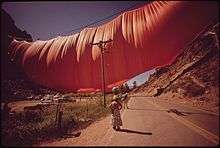
At the end of 1970, Christo and Jeanne-Claude began their preparations for the Valley Curtain project. A 400-meter-long cloth was to be stretched across Rifle Gap, a valley in the Rocky Mountains near Rifle, Colorado. The project required 14,000 m2 of cloth to be hung on four steel cables, fastened with iron bars fixed in concrete on each slope, and 200 tons of concrete. The budget increased to $400,000, causing Christo and Jeanne-Claude additional problems with the financing. Finally enough works of art were sold to raise the money and, on 10 October 1971, the orange-coloured curtain was ready for hanging, but was torn to shreds by wind and rock. While a second curtain was being manufactured, Christo received a request from a Berlin art historian to wrap the Reichstag in response to the 1961 "Project for Wrapping a Public Building." On 10 August 1972, the second attempt to hang the cloth succeeded, but only 28 hours later it was destroyed by a storm gale in excess of 60 miles per hour.
The project was shown in the documentary film Christo's Valley Curtain, by David and Albert Maysles, which was nominated for an Academy Award for Best Documentary Short.[16]
Running Fence
In 1972, Christo and Jeanne-Claude began preparations for Running Fence: a fabric fence, supported by steel posts and steel cables, running through the landscape and leading into the sea. The fence was to be 5.5 meters high and 40 kilometers long and constructed in Sonoma and Marin Counties, California. For the project, 59 families of ranchers needed to be convinced and the permission of the authorities had to be obtained, so Christo and Jeanne-Claude hired nine lawyers. At the end of 1973, Christo and Jeanne-Claude marked the path of the fence with wooden stakes. On 29 April 1976, the work finally began after a long struggle against bureaucracy. Approximately 200,000 m2 of nylon fabric, 2050 steel posts and 145 km of steel cable were needed. On 10 September 1976 the work was completed. However, Christo and Jeanne-Claude had to pay a $60,000 fine, because they lacked permission for the coastal region.
Wrapped Walk Ways
In 1977, Christo and Jeanne-Claude were mostly paying bank loans and trying to save money. In addition, however, they continued to plan their future projects, like wrapping the Reichstag in Berlin and the Pont-Neuf in Paris, as well as Wrapped Walk Ways, a covering of footpaths in a Kansas City park. In November, Christo met his parents, seeing his mother for the first time in 20 years.
With Wrapped Walk Ways Christo and Jeanne-Claude covered 4.5 km of footpaths in Loose Park, a park in Kansas City, Missouri. Altogether it required 12,500 m2 of orange-yellow-coloured shiny nylon fabric. Pedestrians enjoyed the artwork for two weeks in October. The cost of this project amounted to $130,000.
Surrounded Islands
Christo and Jeanne-Claude planned a project based on Jeanne-Claude's idea to surround eleven islands in Miami's Biscayne Bay with 603,850 m2 of pink polypropylene floating fabric. It was completed on May 7, 1983, with the aid of 430 workers and could be admired for two weeks.
On May 7, 1983, the installation of Surrounded Islands was completed. In Biscayne Bay, between the municipalities of Miami, Miami Shores, North Miami, North Bay Village, Bal Harbour, Surfside and Miami Beach, 11 of the islands situated in the area of Baker's Haulover Inlet, Broad Causeway, 79th Street Causeway, Julia Tuttle Causeway, and Venetian Causeway were surrounded with 603,850 square meters (6.5 million square feet) of pink woven polypropylene fabric covering the surface of the water, floating and extending out 61 meters (200 ft) from each island into the bay. The fabric was sewn into 79 patterns to follow the contours of the 11 islands.
For two weeks Surrounded Islands, spreading over 11.3 kilometers (7.0 mi), was seen, approached, and enjoyed by the public, from the causeways, the land, the water, and the air. The luminous pink color of the shiny fabric was in harmony with the tropical vegetation of the uninhabited, verdant islands, the light of the Miami sky, and the colors of the shallow waters of Biscayne Bay.
Since April 1981, attorneys Joseph Z. Fleming and Joseph W. Landers, marine biologist Anitra Thorhaug, ornithologists Oscar Owre and Meri Cummings, mammal biologist Daniel Odell, marine engineer John Michel, four consulting engineers, and builder-contractor Ted Dougherty of A & H Builders, Inc., had been working on the preparation of the Surrounded Islands. The marine and land crews picked up debris from the eleven islands, putting refuse in bags and carting it away after they had removed some forty tons of varied refuse: refrigerator doors, tires, kitchen sinks, mattresses, and an abandoned boat.
Permits were obtained from the following governmental agencies: The Governor of Florida and the Cabinet; the Dade County Commission; the Florida Department of Environmental Regulation; the City of Miami Commission; the City of North Miami; the Village of Miami Shores; the U.S. Army Corps of Engineers; and the Dade County Department of Environmental Resources Management.
From November 1982 until April 1983, 6,500,000 square feet (600,000 m2) of woven polypropylene fabric were sewn at the rented Hialeah factory, into 79 different patterns to follow the contours of the 11 islands. A flotation strip was sewn in each seam. At the Opa Locka Blimp Hangar, the sewn sections were accordion-folded to ease their unfurling on the water.
The outer edge of the floating fabric was attached to a 30.5 centimeter (12 inch) diameter octagonal boom, in sections, of the same color as the fabric. The boom was connected to the radial anchor lines, which extended from the anchors at the island to the 610 specially made anchors, spaced at 15.3 meter (50 ft) intervals, 76 meters (250 ft) beyond the perimeter of each island, driven into the limestone at the bottom of the bay. Earth anchors were driven into the land, near the foot of the trees, to secure the inland edge of the fabric, covering the surface of the beach and disappearing under the vegetation.
The floating rafts of fabric and booms, varying from 3.7 to 6.7 meters (12 to 22 feet) in width and from 122 to 183 meters (400 to 600 feet) in length, were towed through the Bay to each island. There were 11 islands, but on two occasions two islands were surrounded together as one configuration.
As with Christo and Jeanne-Claude's previous art projects, Surrounded Islands was entirely financed by the artists through the sale by C.V.J. Corporation (Jeanne-Claude Christo-Javacheff, President) of the preparatory pastel and charcoal drawings, collages, lithographs, and early works.
On May 4, 1983, out of a total work force of 430, the unfurling crew began to blossom the pink fabric. Surrounded Islands was tended day and night by 120 monitors in inflatable boats.
Surrounded Islands was a work of art which underlined the various elements and ways in which the people of Miami live, between land and water.
Pont Neuf
On 14 March 1984, Jeanne-Claude became a U.S. citizen; she held dual U.S. and French citizenship. In August, the couple received permission to wrap the Pont-Neuf, (which had been completed in July 1607), after nine years of negotiations with the mayor of Paris, Jacques Chirac, and preparations for the project began. For the wrapping of the oldest bridge in Paris, 40,000 m2 of sand-colored polyamide fabric was needed. The golden sandstone color is used to imitate the color of pavements in Paris under sunset. The wrapping began on 25 August 1985 and was completed on 22 September. On the 5th of October, the project was removed after being viewed by over three million visitors. All the expenses for The Pont Neuf Wrapped were borne by the couple themselves. Just as in all other projects, they do not take sponsorship. They usually utilize the money they make just selling the preliminary drawings of the project. Wrapping the Pont Neuf continued the tradition of transforming a sculptural dimension into a work of art. The fabric maintained the principal shapes of the Pont Neuf but it emphasized the details and the proportions.
The Umbrellas, Japan–USA, 1984–1991
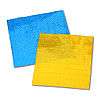
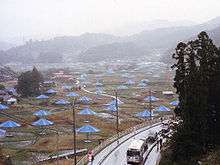
Christo and Jeanne-Claude prepared for their next project, The Umbrellas. The plan was to have yellow umbrellas set up in California and blue umbrellas in Japan at the same time. In December 1990, after much preparation, the first steel bases for the umbrellas were installed. At the bases 80 cm long anchors were fastened to the ground to withstand tensions of 1,500 kgf (15 kN). In September 1991 the umbrellas were brought to their places by 2,000 workers. In California, some of the bases were transported to the site by helicopter. The final cost of the project totaled $26 US million, and it was completely financed by the artists themselves through sale of preparatory drawings etc; the artists do not take any form of sponsorship.
By September 7, 1,340 blue umbrellas in Ibaraki and 1,760 yellow umbrellas at the Tejon Ranch in southern California had been set up; the exhibition opened on 9 October 1991. The umbrellas were positioned closely together in the limited space of Japan, whereas in California they were placed in all directions in its vast uncultivated land. In total, three million people saw the umbrellas, each measuring 6 meters in height and 8.66 meters in diameter. On October 27, they started the removal of this project and restored the land to earlier condition. The umbrellas were taken apart and most of the elements were recycled. The umbrellas became a huge tourist attraction, finding use as everything from picnic spots to wedding altars.
On 26 October 1991, one of the umbrellas in California was toppled by high winds, killing one woman and injuring several others. The exhibit was ordered closed immediately.[17] A second death occurred during the removal of the umbrellas.[18]
Wrapped Reichstag
After the project The Umbrellas, Christo and Jeanne-Claude concerned themselves again with wrapping the Reichstag in Berlin. With the support of the President of the Parliament, Rita Süssmuth, Christo and Jeanne-Claude worked to convince the elected Members of Parliament, going from office to office, writing explanatory letters to each of the 662 delegates and innumerable telephone calls and negotiations. On 25 February 1995, after a 70-minute debate at the Parliament and a Roll Call vote, the Bundestag allowed the project to go ahead.
Just under 100,000 m2 of fireproof polypropylene fabric, covered by an aluminum layer, and 15 km of rope were needed. The wrapping began on 17 June 1995 and was finished on 24 June. The spectacle was seen by five million visitors before the unveiling began on 7 July.[19]









 Pencil signature of Christo from 1987
Pencil signature of Christo from 1987
Verhüllte Bäume (Wrapped Trees)
After 32 years of planning and preparation work, between 13 November and 14 December 1998, Christo and Jeanne-Claude wrapped 178 trees in the Beyeler Foundation's "Berower Park" in the north-eastern part of Basel, alongside the road and tram line from the German frontier at Riehen (Lörrach).
To wrap the trees, the couple used 55,000 m2 of silver-grey shiny polyester fabric and 23 km of rope. A pattern had to be made for each individual tree so that the natural shape of the branches pushed the fabric outwards, creating individual shapes in the sky. The trees varied in height from 2 to 25 meters and in width from 1 to nearly 15 meters. As with their other projects, this was financed by the sale of original works. On view for three weeks, Wrapped Trees was extremely dynamic: varying silhouettes of trees moved in the wind with the skeletal framework of branches made visible when the translucent material was backlit by the winter sun. All materials used were recycled when it was taken down.
Wrapped Snoopy House
In 1978, Charles M. Schulz drew an episode of his comic strip Peanuts in which Snoopy's doghouse is wrapped in fabric by Christo.[20] In response, Christo constructed a wrapped doghouse and presented it to the Charles M. Schulz Museum in 2003.[21]
The Gates

On 3 January 2005, work began on the installation of the couple's most protracted project, The Gates, in Central Park in New York City. The title is The Gates, Central Park, New York, 1979–2005 in reference to the time that passed from their initial proposal until they were able to go ahead with it: only with the permission of the new mayor of New York, Michael R. Bloomberg, were they able to proceed. After the project was completed, Bloomberg released the following statement about The Gates, “Mayor Michael R. Bloomberg, [...] praised The Gates as ‘one of the most exciting public art projects ever put on anywhere in the world — and it would never have happened without Jeanne-Claude.’”[14]
The Gates was open to the public from 12 to 27 February 2005. A total of 7,503 gates made of saffron color fabric were placed on paths in Central Park. They were five meters high and had a combined length of 37 km. Bloomberg, a fan of Christo and Jeanne-Claude, presented them with the "Doris C. Freedman Award for Public Art" for the work of art.[22] Christo and Jeanne-Claude often expressed satisfaction that their concept for their home town of over 30 years was finally realized.
The cost of the project was US$21 million, which was raised entirely by Christo and Jeanne-Claude selling studies, drawings, collages, an works from the 1950s and 1960s. They did not accept any sponsorship, nor did the city of New York have to provide any money for the project. Christo and Jeanne-Claude donated all the money raised from the sale of souvenirs such as postcards, T-shirts and posters to "Nurture New York's Nature, Inc." While the engineering, manufacturing and set-up took over a year, about 750 paid employees erected the project in five days and then deployed the fabric of all the gates in half an hour. Around 600 more "gate-keepers" distributed one million free fabric samples to visitors. The uniformed gate-keepers provided information to visitors about the project, and were responsible for unrolling the gates that had rolled over their crossbars in the high wind. More workers uninstalled the project in one week, leaving almost no trace, and shipping all the materials for recycling.
Big Air Package
Christo filled the Gasometer Oberhausen from 16 March until 30 December 2013 with the installation Big Air Package. After The Wall (1999) as the finale installation of the Emscher Park International Building Exhibition, Big Air Package was his second work of art in the Gasometer. The “Big Air Package – Project for Gasometer Oberhausen, Germany“ was conceived by Christo in 2010 (for the first time without his wife Jeanne-Claude). The sculpture was set up in the interior of the industrial monument and was made of 20,350 square metres of translucent fabric and 4,500 metres of rope. In the inflated state, the envelope, with a weight of 5.3 tons, reached a height of more than 90 metres, a diameter of 50 metres and a volume of 177,000 cubic metres. The monumental work of art was, temporarily, the largest self-supporting sculpture in the world. In the accessible interior of Big Air Package, the artist generated a unique experience of space, proportions and light.[23]
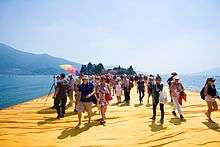
The Floating Piers
The Floating Piers were a series of walkways installed at Lake Iseo near Brescia, Italy. From June 18 to July 3, 2016, visitors were able to walk just above the surface of the water from the village of Sulzano on the mainland to the islands of Monte Isola and San Paolo. The floating walkways were made of around 200,000 polyethylene cubes covered with 70,000 square metres (750,000 sq ft) of bright yellow fabric: 3 kilometres (1.9 mi) of piers moved on the water; another 1.5 kilometres (0.93 mi) of golden fabric continued along the pedestrian streets in Sulzano and Peschiera Maraglio. After the exhibition, all components were to be removed and recycled.[24] The installation was facilitated by the Beretta family, owners of the primary side arm supplier of the American Army.[25] The Beretta family owns the island of San Paolo, which was surrounded by Floating Piers walkways.[26]
.jpg)
The Mastaba
The Mastaba is a temporary floating installation to be exhibited from June to September 2018 on The Serpentine in London. The installation consists of 7,506 oil barrels, in the shape of a mastaba, a form of ancient Egyptian tomb with a flat roof and inward sloping sides. It sits on a floating platform of high-density polyethylene, held in place by 32 anchors. It is 20 metres (66 ft) in height and weighs 600 tonnes (660 tons). The vertical ends have been painted in a mosaic of red, blue and mauve, whilst the sloping sides are in red with bands of white.[27]
Simultaneously with the display of The Mastaba, the nearby Serpentine Gallery is presenting an exhibition of the artists' work, entitled Christo and Jeanne-Claude: Barrels and The Mastaba 1958–2018. The exhibition comprises sculptures, drawings, collages, scale-models and photographs from the last 60 years of the artists' work.[28]
Future works
Over The River
Christo and Jeanne-Claude announced plans for a future project, titled Over The River, to be constructed on the Arkansas River between Salida, Colorado and Cañon City, Colorado on the eastern slope of the Rocky mountains. This scenic area is known as Bighorn Sheep Canyon, and is west of the well-known Royal Gorge. Plans for the project call for horizontally suspending 6.7 miles (10.8 km) of reflective, translucent fabric panels high above the water, on steel cables anchored into the river's banks. Project plans call for its installation for two weeks during the summer of 2015, at the earliest, and for the river to remain open to recreation during the installation.
Reaction among area residents has been intense with supporters hoping for a tourist boom and opponents fearing that the project would ruin the visual appeal of the landscape and inflict damage on the river ecosystem. One local rafting guide compared the project to "hanging pornography in a church." The Bureau of Land Management released a Record of Decision approving the project on November 7, 2011.[29][30][31] Work on the project cannot begin, however, until the Bureau of Land Management issues a Notice to Proceed.[32] A lawsuit against the Colorado Division of Parks and Wildlife was filed on July 22, 2011, by Rags Over the Arkansas River (ROAR), a local group opposed to the project.[33] The lawsuit is still awaiting a court date.[34]
Christo and Jeanne-Claude's inspiration for Over the River came in 1985 as they were wrapping the Pont-Neuf and a fabric panel was being elevated over the Seine. The artists began a three-year search for appropriate locations in 1992, considering some eighty-nine river locations. They chose the Arkansas River because its banks were high enough that recreational rafters could enjoy the river at the same time.[35]
Christo and Jeanne-Claude have already spent more than $6 million on environmental studies, design engineering, and wind-tunnel testing of fabrics. As with past projects, Over The River would be financed entirely by Christo and Jeanne-Claude, through the sale of Christo’s preparatory drawings, collages, scale models, and early works of the 1950s/1960s. On July 16, 2010, the U.S. Bureau of Land Management released its four-volume Draft Environmental Impact Statement, which reported many potentially serious types of adverse impact but also many proposed "mitigation" options.[36] [37]
In January 2017, after the election of President Trump, Christo cancelled the controversial project in protest of the new administration.[38][39]
Mastaba (Al Gharbia)
The Mastaba is a planned trapezoidal structure of over 400,000 oil barrels, intended to be built at Al Gharbia, 100 miles from Abu Dhabi.[40][41] It will, if realised, be the only lasting large-scale Christo/Jeanne-Claude artwork.
Public collections
- Boca Raton Museum of Art
- Musée d'art moderne et d'art contemporain, Nice, France
- Cleveland Museum of Art: Wrapped Chair (1961)
- Los Angeles County Museum of Art: Portrait of Ray 1969
Honors and awards
- (2011) Awarded honorary degrees from Occidental College.
- (2011) Elected into the National Academy of Design
- (2008) Awarded honorary degrees from Franklin & Marshall College.
- (2006) Best Project in a Public Space for The Gates, Central Park, New York, 1979-2005, AICA-USA Awards
- (2006) Vilcek Prize in Fine Art[42]
- (2004) Achievement in Contemporary Sculpture Award, International Sculpture Center, Hamilton, NJ, USA
- "Doris C. Freedman Award for Public Art"[22]
- (1973) Nominated for an Academy Award for Best Documentary Short.[16]
See also
References
- Notes
- 1 2 3 4 5 Grimes, William (November 19, 2009). "Jeanne-Claude, Collaborator With Christo, Dies at 74". The New York Times. Retrieved November 20, 2009.
- 1 2 Miller, Stephen; Crow, Kelly (November 20, 2009). "Part of a Creative Powerhouse Behind Ephemeral Artworks". The Wall Street Journal. Dow Jones. Retrieved 2009-11-20.
- ↑ Bourdon, David: "Christo", Harry N. Abrams Publishers, Inc., New York City, 1970.
- ↑ Living with Art, Mark Getlein
- ↑ Randy Kennedy (January 25, 2017). "Christo, Trump and the Art World's Biggest Protest Yet". The New York Times.
- ↑ Vogel, Carol (21 October 2015). "Next From Christo: Art That Lets You Walk on Water". Retrieved 15 April 2018 – via NYTimes.com.
- 1 2 Hoelterhoff, Manuela (November 20, 2009). "Jeanne-Claude -- Christo's Dynamic Muse". Bloomberg L.P. Retrieved 2009-11-20.
- ↑ LXTV (July 26, 2007). The artists behind The Gates Christo and Jeanne-Claude. YouTube. Event occurs at 2:20. Retrieved 2009-11-20.
- ↑ "Artist Jeanne-Claude dies aged 74". BBC News. November 20, 2009. Retrieved 2009-11-19.
- ↑ "Jeanne-Claude". London: The Telegraph. November 20, 2009. Retrieved 2009-11-20.
- ↑ Schudel, Matt (November 20, 2009). "Jeanne-Claude and Christo". The Washington Post. Retrieved 2009-11-20.
- ↑ Keats, Jonathon, Christo is Building the World's Biggest Sculpture, Forbes
- ↑ Lewis, Richard, and Susan Lewis. "Cengage Advantage Books: The Power of Art." Google Books. Cengage Learning, 23 Jan. 2008. Web. 04 Mar. 2015.
- 1 2 Grimes, William. "Jeanne-Claude, Christo’s Collaborator on Environmental Canvas, Is Dead at 74." The New York Times. The New York Times, 19 Nov. 2009. Web. 04 Mar. 2015.
- ↑ Baal-Teshuva, Jacob (July 1, 2001). Christo and Jeanne-Claude. Taschen. p. 18. ISBN 978-3822859964.
- 1 2 "Christo's Valley Curtain". The New York Times. Retrieved 2008-11-30.
- ↑ "Christo Umbrella Crushes Woman". The New York Times. October 28, 1991. Retrieved 2011-04-20.
- ↑ "2d Person Is Killed In Christo Art Project". The New York Times. November 1, 1991. Retrieved 2012-12-01.
- ↑ "Christo and Jeanne-Claude: Wrapped Reichstag". Washington, DC: National Gallery of Art. Archived from the original on 2011-10-23. Retrieved 2011-11-05.
- ↑ "Peanuts".
- ↑ "Christo's Wrapped Snoopy House". Charles M. Schulz Museum (Permanent Exhibitions). Archived from the original on July 8, 2008.
- 1 2 "2005: Art World Year-in-Review". ARTINFO. December 25, 2005. Retrieved 2008-04-17.
- ↑ NoFavorite. "Projects - Big Air Package". www.christojeanneclaude.net. Retrieved 15 April 2018.
- ↑ "Christo: The Floating Piers, Project for Lake Iseo, Italy". christojeanneclaude.net. Retrieved 2015-09-07.
- ↑ "Esplora il significato del termine: La signora Beretta e l'isola di famiglia nell'opera di Christo da 15 milioni di euroLa signora Beretta e l'isola di famiglia nell'opera di Christo da 15 milioni di euro". corriere.it. Retrieved 2016-04-08.
- ↑ Mesco, Manuela (18 June 2016). "Christo Walks on Water With New Italian Installation". Wall Street Journal. Retrieved 19 July 2016.
- ↑ Block, India (18 June 2018). "Christo unveils floating Serpentine sculpture made from 7,506 barrels". De Zeen. Archived from the original on 18 June 2018. Retrieved 18 June 2018.
- ↑ "Christo and Jeanne-Claude: Barrels and The Mastaba 1958–2018". Serpentine Gallery. Archived from the original on 22 June 2018. Retrieved 22 June 2018.
- ↑ Blevins, Jason (22 August 2010). "Local viewpoints wide apart on Christo's plan to drape fabric over Arkansas River". Denver Post.
- ↑ Crow, Kelly (September 10, 2010). "Christo vs. Colorado". Wall Street Journal September 10, 2010.
- ↑ "BLM Over The River Record of Decision". Bureau of Land Management. November 7, 2011. Archived from the original on February 1, 2012.
- ↑ "News and Events". Rags Over the Arkansas River (ROAR). November 21, 2011. Archived from the original on November 11, 2011.
- ↑ Blevins, Jason (July 27, 2011). "Foes of Christo's plan to cover Arkansas River with fabric sue state park board". Denver Post.
- ↑ Ericka, Kastner (November 1, 2011). "OTR lawsuit awaits court date". The Mountain Mail.
- ↑ Cathy, Newman (November 2006). "Christo and Jeanne-Claude Unwrapped". National Geographic.
- ↑ Johnson, Kirk (July 16, 2010). "Bureaucracy Meets Art, Delighting Christo". The New York Times July 17, 2010.
- ↑ Crow, Kelly (10 September 2010). "Christo vs. Colorado". Retrieved 15 April 2018 – via www.wsj.com.
- ↑ Randy Kennedy, Christo, Trump and the Art World’s Biggest Protest Yet The New York Times 2017/01/25
- ↑ COREY H. JONES, Artist Christo Calls Off Colorado Project After Long Legal Battle Colorado Public Radio JAN 25, 2017
- ↑ "The Mastaba". Christo and Jeanne-Claude. Retrieved 27 January 2017.
- ↑ Ng, David (November 26, 2012). "Will Christo's oil-barrel pyramid 'Mastaba' finally rise?". LA Times. Archived from the original on 2013-03-12. Retrieved 2013-03-12.
- ↑ "The Vilcek Foundation -". www.vilcek.org. Retrieved 2015-11-11.
- Source
- This article is based on a translation of the corresponding article from the German Wikipedia, accessed on 3 May 2005, with additional material on the Over the River project from the artists' website and newspapers.
- Bibliography
For information about the early work of Christo and Jeanne-Claude see:
- Matthias Koddenberg, Christo: The Paris Sculptures 1961, Kettler Verlag, Bönen, Germany 2011
- Matthias Koddenberg, Christo and Jeanne-Claude: Early Works 1958-64, Kettler Verlag, Bönen, Germany 2009
- Matthias Koddenberg, "Christo and Jeanne-Claude: Realism's Newly Unveiled Face", in: Nouveau Réalisme, exh. cat. Museum Moderner Kunst Stiftung Ludwig Wien, Vienna, Austria 2005
- David Bourdon, Christo, Harry N. Abrams, New York, USA 1971
For information about specific projects of Christo and Jeanne-Claude see:
- Anne L. Strauss, Christo and Jeanne-Claude: The Gates, Central Park, New York City, 1979–2005, Taschen Verlag, Cologne, Germany 2005
- Christo: 5.600 Cubicmeter Package, Verlag Wort und Bild, Baierbrunn, Germany 1968
- Five Films about Christo & Jeanne-Claude: A Maysles Films Production, N.Y., N.Y. : Plexifilm, 2004.
For general information about the life and work of Christo and Jeanne-Claude see:
- Matthias Koddenberg, Christo and Jeanne-Claude: In/Out Studio, D.A.P., New York, USA 2015
- Christo and Jeanne-Claude: 40 Years - 12 Exhibitions, exh. cat. Annely Juda Fine Art, London, Great Britain 2011
- Jacob Baal-Teshuva, Christo and Jeanne-Claude, Taschen Verlag, Cologne, Germany 2005
- Burt Chernow, Christo and Jeanne-Claude: A Biography, St. Martin's Press, New York, USA 2002
External links
| Wikimedia Commons has media related to Christo. |
- Official website

- Interview with Wolfgang Volz, photographer and technical director of The Floating Piers
- Works by or about Christo in libraries (WorldCat catalog)
- Works by or about Jeanne-Claude in libraries (WorldCat catalog)
- "Christo collected news and commentary". The New York Times.
- Interview with Christo and Jeanne-Claude
- Christo and Jeanne-Claude in the Vogel Collection at the National Gallery of Art
- artfacts.net entry, including exhibition information
- The Gates @ Central Park Community blogging project about Christo's February 2005 NYC art installation.
- Wrapped Snoopy House at the Schulz Museum
- Over the River information from the artists' website
- Rags Over the Arkansas River (ROAR)
- Wolfgang Volz, photographer
- The Pont Neuf Wrapped, 1985. Photos: Eric Baudelet
- Christo in Paris (1990) Documentary movie on wrapping the Pont-Neuf bridge in Paris.
- Christo and George Gurney of the Smithsonian American Art Museum talk about the Running Fence archive
- Christo talks about Over The River
- Christo vs Colorado, 2010, September 11
- Vote for Christo's Wrapping of the Reichstag Speech in the German Bundestag, 1994 by Konrad Weiß (Berlin)
- Art Signature Dictionary, genuine signature by the artist Christo Javacheff Here are several dated examples of Christo Javacheff signature.
- Jeanne-Claude
- Obituary in The Guardian
- Obituary in The Independent by Marcus Williamson
- Obituary in the Daily Telegraph